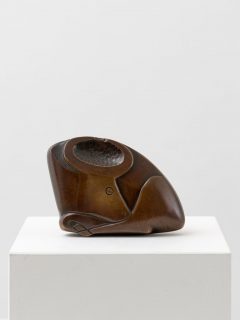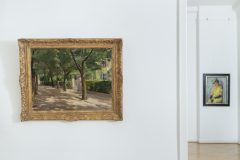Max Liebermann
Colomierstraße in Wannsee
1916

Oil on canvas
72 × 91 cm / 28 3/8 × 35 13/16 in
Signed and dated
Catalogue Raisonné by Eberle 1996 no. 1919/16
Expert opinion by Prof. Dr. Matthias Eberle, Das Max Liebermann-Archiv, Berlin
Kunsthandlung Paul Cassirer, Berlin (acquired and sold on 1 Sep. 1916); Kunsthandlung J.P. Schneider, Frankfurt a. Main (1 Sep. 1916-); Private Collection Frankfurt a.M. (-1927); Cassirer-Helbing, Berlin (1927); Kunsthandlung F.A.C. Prestel, Frankfurt a.M., (98. Auction, 6 March 1929, lot 66); Collection Hermann Hugo Neithold, Dresden (1929-1939); Estate of Collection Neithold, Dresden (1939-2022)
- Galerie Ludorff, Neuerwerbungen Frühjahr 2023, Düsseldorf 2023
- Kunstsammlungen und Museen Augsburg, "Ein Kaufmann als Kunstfreund. Die Gemäldesammlung von Hermann Hugo Neithold", Augsburg 2016
- Galerie Ludorff, "Neuerwerbungen Frühjahr 2023", Düsseldorf 2023, S. 82
- Kunstsammlungen und Museen Augsburg (Hg.), "Ein Kaufmann als Kunstfreund. Die Gemäldesammlung von Hermann Hugo Neithold", Ausst.-Kat., Berlin/München 2016, Nr. 13
- Matthias Eberle, "Max Liebermann. Werkverzeichnis der Gemälde und Ölstudien 1900-1935", Bd. II, München 1996, Nr. 1916/16
- Holly Prentiss Richardson, "Landscape in the Work of Max Liebermann", Ann Arbor 1991, S. 204, Nr. 579
With the purchase of the property near Berlin's Wannsee in 1909, Max Liebermann not only created a new home for himself and his family, but also found a recurring motif for later works. Within a year, he had a stately villa built on the property, where he would live for the rest of his life.
From 1910 onwards, Liebermann painted numerous works depicting the private residence as well as the surrounding garden in various layers and perspectives. Liebermann's preference for open-air painting is particularly evident in these depictions. His masterful sense of light and shadow at different times of the day and year make his works particularly atmospheric and atmospheric. Despite recurring or similar motifs, no two works are the same.
In this painting, Max Liebermann presents us with a view of Colomierstrasse. Colomierstrasse runs along the side of Liebermann's villa in the direction of Wannsee and offers a small view of the blue lake at the end. The avenue is lined with trees to the left and right. The dense treetops only allow light to shine through at certain points, creating an exciting pattern of light and shadow on the ground. The lush, multi-faceted green of the trees and the meticulously trimmed hedge in front of his house suggest that the picture must have been taken on a spring or summer's day. The long avenue, which tapers as the depth of the picture increases, provides compositional straightness and contrasts with the artist's light and dynamic brushstroke. It is not difficult to recognise that Max Liebermann was inspired by his French forerunners and contemporaries of Impressionism. In contrast to them, however, his work is coarser and more naturalistic.
With this work, Liebermann documented his "kleines Schlösschen", as he liked to call it, and at the same time symbolised what he felt was an ideal image of his private and working environment.
Hermann Hugo Neithold bought the painting in 1929 for his private art collection. The German private owner built up an important collection with works by his contemporaries, including two paintings by Max Liebermann and one by Lovis Corinth, which has survived to this day.






